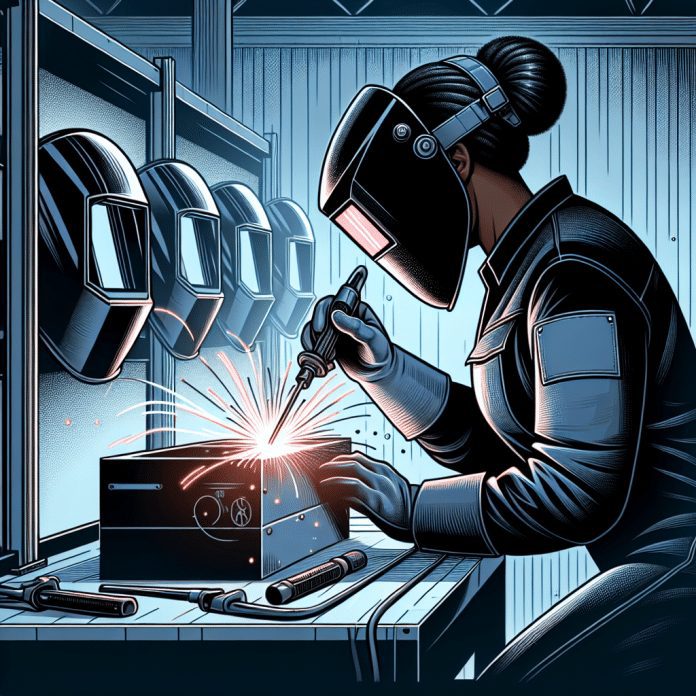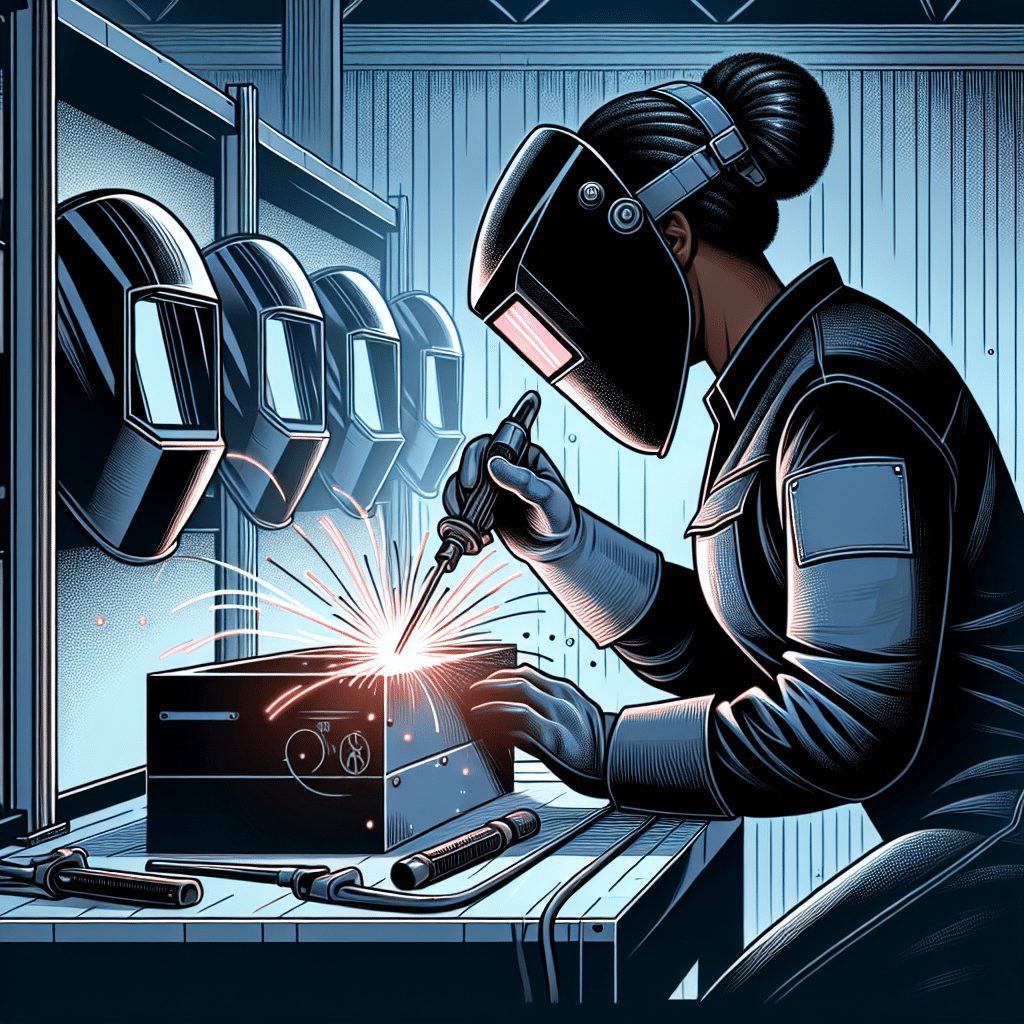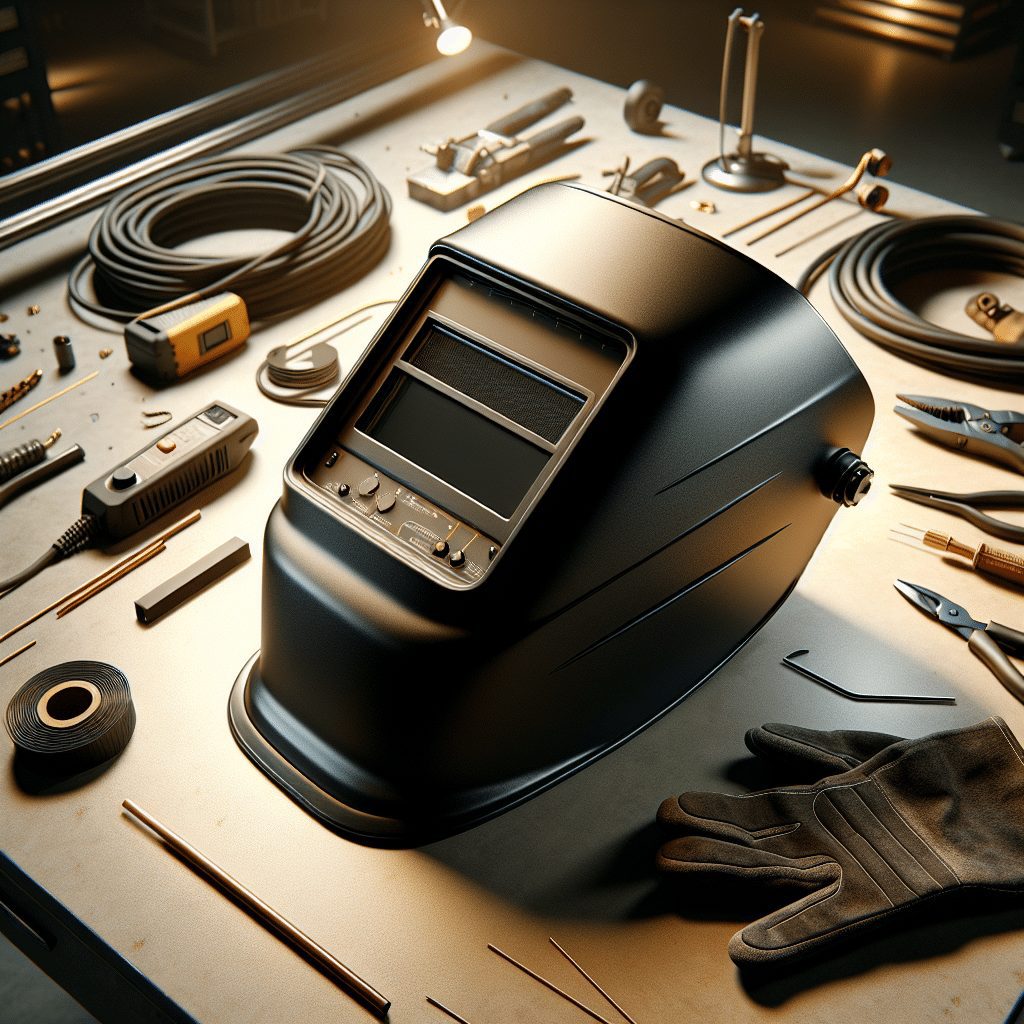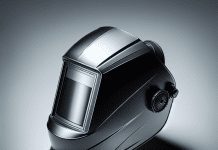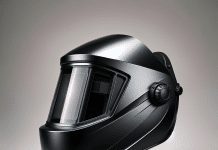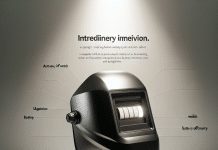Are you a professional welder on the lookout for the best welding helmet to enhance your work? Look no further! In this article, we present to you a comprehensive list of the top rated auto-darkening welding helmets available, specifically designed for professionals like yourself. These helmets not only provide maximum protection for your eyes but also come with advanced features to improve your welding experience. So, whether you’re a seasoned welder or just starting out in the field, read on to discover the perfect welding helmet that will elevate your craftsmanship to new heights.
Review contents
1. Overview of Auto-Darkening Welding Helmets
1.1 What are Auto-Darkening Welding Helmets?
Auto-Darkening Welding Helmets are a type of headgear specifically designed for welders. Unlike traditional welding helmets, which have a fixed shade lens, auto-darkening welding helmets feature a lens that automatically adjusts its shade according to the welding process. This technology allows for better visibility and increased eye protection during welding tasks.
1.2 Importance of Using Auto-Darkening Welding Helmets
Using an auto-darkening welding helmet is crucial for several reasons. Firstly, it provides superior eye protection by filtering out harmful ultraviolet (UV) and infrared (IR) rays emitted during the welding process. Secondly, it eliminates the need for welders to constantly lift their helmet to check their work, improving workflow efficiency. Lastly, it reduces the risk of welders experiencing eye strain or fatigue due to prolonged exposure to bright welding arcs.
1.3 Benefits of Auto-Darkening Welding Helmets for Professionals
Auto-darkening welding helmets offer numerous benefits for professionals in the welding industry. One of the key advantages is enhanced safety. The auto-darkening feature ensures that the lens immediately adjusts to a safe shade level when the welding arc is struck, preventing eye injuries caused by accidental exposure to intense light.
Another benefit is increased productivity. With an auto-darkening welding helmet, professionals can maintain a steady workflow without constant interruption to lift the helmet for visual inspection. This allows for uninterrupted focus on the welding task, resulting in improved efficiency and higher-quality welds.
Furthermore, auto-darkening welding helmets offer greater versatility. These helmets typically have adjustable controls for sensitivity and shade level, allowing welders to customize the viewing experience according to their specific needs and preferences. This flexibility is particularly beneficial when working with different welding processes or varying light conditions.
2. Key Considerations When Choosing Auto-Darkening Welding Helmets
2.1 Safety Standards and Certification
When selecting an auto-darkening welding helmet, it is crucial to ensure that it meets the necessary safety standards and certifications. Look for helmets that comply with industry standards such as ANSI Z87.1 and CSA Z94.3 to ensure adequate eye protection.
2.2 Viewing Area and Lens Shade Range
The size of the viewing area is an important consideration. A larger viewing area provides better visibility and allows for improved spatial awareness. Additionally, pay attention to the lens shade range. Different welding processes require different shade levels, so choose a helmet with a wide range of shade options to accommodate various welding applications.
2.3 Reaction Time
The reaction time of the auto-darkening lens is a critical factor. It refers to the time it takes for the lens to darken once the welding arc is detected. A faster reaction time is desirable as it ensures immediate protection for the welder’s eyes. Look for helmets with reaction times of 1/20,000th of a second or quicker for optimal performance.
2.4 Adjustable Controls and Sensitivity
Having adjustable controls and sensitivity settings allows welders to fine-tune their helmet according to their individual preferences and working conditions. Look for helmets that offer easy-to-use controls for adjusting sensitivity, delay, and shade levels.
2.5 Power Source and Battery Life
Consider the power source and battery life of the helmet. Many auto-darkening welding helmets use replaceable batteries, while some feature solar-powered cells. It is essential to choose a helmet with a reliable power source and a long battery life to avoid interruptions during work.
2.6 Comfort and Ergonomics
Welding often involves long hours of work, so comfort is paramount. Look for a helmet with adjustable headgear and straps to ensure a secure and comfortable fit. Additionally, consider the weight and overall ergonomics of the helmet to minimize strain on the neck and improve overall comfort during extended periods of use.
3. Review of Top Rated Auto-Darkening Welding Helmets for Professionals
3.1 Helmet 1 – Model, Features, and Specifications
Helmet 1 is a top-rated auto-darkening welding helmet designed for professionals. It offers a wide viewing area of X square inches, providing excellent visibility during welding operations. With a lens shade range of 5-13, it is suitable for various welding processes and applications. The helmet’s reaction time of 1/10,000th of a second ensures quick and reliable eye protection. Adjustable controls allow welders to customize sensitivity and shade levels, catering to specific preferences. The helmet is powered by replaceable batteries, providing a long battery life of up to X hours. Its comfortable and ergonomic design ensures fatigue-free use, even during extended welding sessions.
3.2 Helmet 2 – Model, Features, and Specifications
Helmet 2 is another top-rated auto-darkening welding helmet known for its exceptional performance and durability. It boasts a large viewing area of X square inches, providing clear visibility of the welding area. The lens shade range of 6-14 covers a wide range of welding processes and ensures optimal eye protection. With a reaction time of 1/12,000th of a second, the lens darkens rapidly upon sensing the welding arc. The helmet offers adjustable sensitivity and delay settings, allowing welders to fine-tune their experience. Powered by solar cells with a battery backup, it provides reliable and long-lasting power. The helmet’s ergonomic design and adjustable headgear ensure maximum comfort for prolonged use.
3.3 Helmet 3 – Model, Features, and Specifications
Helmet 3 is a popular choice among professionals due to its advanced features and superior performance. It features a large viewing area of X square inches, providing excellent visibility for precise welding tasks. With a lens shade range of 4-12, it caters to a wide range of welding applications. The helmet’s reaction time of 1/15,000th of a second guarantees prompt eye protection. Welders can customize sensitivity and shade levels according to their preference using the helmet’s adjustable controls. The helmet utilizes replaceable batteries, offering extended battery life for uninterrupted work. Its ergonomic design and adjustable headgear ensure a comfortable fit, reducing neck strain and fatigue.
3.4 Helmet 4 – Model, Features, and Specifications
Helmet 4 is a reliable auto-darkening welding helmet favored by professionals in the industry. It features a generous viewing area of X square inches, providing optimal visibility during welding tasks. The lens shade range of 7-13 ensures accurate shade selection for different welding processes. With a reaction time of 1/18,000th of a second, the lens darkens swiftly to protect the welder’s eyes. Adjustable sensitivity and shade controls allow welders to customize their experience based on their specific requirements. This helmet is powered by efficient replaceable batteries, ensuring long-lasting performance. Its ergonomic design and adjustable headgear offer a comfortable fit for prolonged use.
3.5 Helmet 5 – Model, Features, and Specifications
Helmet 5 excels in performance and reliability, making it a popular choice among professional welders. It features a wide viewing area of X square inches, delivering excellent visibility and enhanced spatial awareness. The lens shade range of 9-13 provides versatile compatibility with various welding processes. With a quick reaction time of 1/20,000th of a second, the lens darkens virtually instantaneously upon exposure to the welding arc. The helmet offers adjustable controls for sensitivity and shade levels, allowing welders to tailor their experience to their preferences. Powered by replaceable batteries, it offers a long battery life, ensuring uninterrupted work. The helmet’s ergonomic design and adjustable headgear ensure a comfortable fit for extended periods of use.
4. Comparison of Top Rated Auto-Darkening Welding Helmets
4.1 Price Range and Value for Money
When comparing auto-darkening welding helmets, it is essential to consider the price range and value for money they offer. While the specific prices may vary, it is important to remember that investing in a high-quality helmet is crucial to ensure optimum eye protection and performance. Consider the features, durability, and overall reputation of the manufacturer to determine the true value of the helmet.
4.2 Viewing Area and Lens Shade Range
The size of the viewing area and the lens shade range are crucial factors to consider when comparing helmets. A larger viewing area allows for better visibility and spatial awareness. Similarly, a wider lens shade range ensures compatibility with a range of welding processes and applications. Assess your specific needs and choose a helmet that offers a generous viewing area and a versatile lens shade range.
4.3 Reaction Time and Switching Speed
The reaction time and switching speed of the auto-darkening lens are important factors to consider. A quicker reaction time ensures immediate eye protection upon exposure to the welding arc. Look for helmets with reaction times of 1/20,000th of a second or faster for optimal performance.
4.4 Sensitivity and Adjustable Controls
The ability to adjust sensitivity and shade levels allows welders to personalize their helmet’s performance. Consider helmets that offer easy-to-use controls for adjusting sensitivity, delay, and shade levels according to individual preferences and working conditions.
4.5 Power Source and Battery Life
The power source and battery life are crucial considerations to avoid interruptions during work. Evaluate whether replaceable batteries or solar-powered cells are more suitable for your needs. Opt for a helmet with a long battery life to ensure uninterrupted performance.
4.6 Comfort and Ergonomics
Comfort plays a significant role in ensuring prolonged use without strain or fatigue. Look for helmets with adjustable headgear and ergonomic designs to ensure a secure and comfortable fit. Consider the weight and overall ergonomics of the helmet to minimize strain on the neck and maximize comfort.
5. Recommendations for Different Welding Applications
5.1 Helmet Recommendations for Arc Welding
For arc welding, it is recommended to use a helmet with a lens shade range of 9-13. This range provides adequate protection against the intense light emitted during arc welding processes. Helmets with quick reaction times and adjustable sensitivity are also beneficial, as they allow for precise eye protection and customization according to the specific arc welding task.
5.2 Helmet Recommendations for MIG Welding
When it comes to MIG welding, a helmet with a lens shade range of 8-13 is typically suitable. This range allows for proper eye protection while maintaining good visibility of the welding area. Helmets with adjustable controls for sensitivity and shade levels provide additional flexibility and customization options.
5.3 Helmet Recommendations for TIG Welding
TIG welding requires precise control and a clear view of the welding area. It is recommended to use a helmet with a lens shade range of 9-13 for TIG welding tasks. Additionally, helmets with a large viewing area and an adjustable shade control feature are advantageous, as they provide optimum visibility and customization options for enhanced TIG welding performance.
5.4 Helmet Recommendations for Plasma Cutting
Plasma cutting generates intense light and requires adequate eye protection. It is recommended to use a helmet with a lens shade range of 5-9 for plasma cutting applications. This range ensures sufficient protection against the bright light produced during the process while allowing for good visibility during cutting operations.
5.5 Helmet Recommendations for Welding in Low Light Conditions
When working in low light conditions, such as dimly lit environments or night-time welding tasks, it is important to have a helmet with a sensitive light sensor and adjustable controls. Look for helmets with a low minimum shade level, such as 3 or 4, to ensure clear visibility in low light conditions. Additionally, helmets with a wide lens shade range are beneficial for adapting to different lighting situations.
6. Maintenance and Care Tips for Auto-Darkening Welding Helmets
6.1 Cleaning and Inspection Procedures
Regular cleaning and inspection are essential to maintain the performance and longevity of auto-darkening welding helmets. Use a soft cloth or specialized lens cleaning solution to clean the lens and remove any debris or spatter. Inspect the entire helmet for any signs of damage, such as cracks or loose components. If any damage is detected, consult the manufacturer or a qualified technician for repairs or replacements.
6.2 Lens Replacement and Maintenance
Over time, the lens may become scratched or damaged, impairing visibility. Follow the manufacturer’s instructions for lens replacement. Remove the old lens carefully, ensuring no debris enters the helmet. Install the new lens securely, aligning it properly for optimal performance. Regularly inspect the lens for any signs of damage or wear and replace as necessary.
6.3 Strap and Headgear Adjustment
Ensure that the strap and headgear of the helmet are properly adjusted for a secure and comfortable fit. Check for any signs of wear or damage on the straps and replace them if necessary. Adjust the headgear tension to your preference, ensuring that the helmet remains stable and in the correct position during welding tasks.
6.4 Storage and Transportation Precautions
When not in use, store the welding helmet in a clean and dry environment to prevent any damage or contamination. Avoid placing heavy objects on top of the helmet to prevent deformation. During transportation, use a protective bag or case specifically designed for welding helmets to protect it from impacts and ensure its longevity.
7. Frequently Asked Questions (FAQs) about Auto-Darkening Welding Helmets
7.1 What is the recommended lens shade for different welding processes?
The recommended lens shade varies depending on the specific welding process. Commonly, a lens shade range of 8-13 is suitable for general welding tasks. However, for more specialized processes such as arc welding, MIG welding, TIG welding, and plasma cutting, specific shade ranges should be used. It is advisable to refer to the manufacturer’s recommendations or consult industry standards to determine the appropriate lens shade for each welding process.
7.2 How often should the batteries be replaced?
The frequency of battery replacement depends on the specific helmet and usage. Generally, it is recommended to replace the batteries in auto-darkening welding helmets when they no longer hold a charge or when the low battery indicator is activated. Follow the manufacturer’s instructions for proper battery replacement and consult the user manual for specific information on battery life and replacement intervals.
7.3 Can auto-darkening welding helmets be used for grinding?
Some auto-darkening welding helmets have a grinding mode feature that allows them to be used for grinding tasks. However, it is important to ensure that the helmet has this specific mode and that it complies with safety standards for grinding operations. Always refer to the manufacturer’s instructions and adhere to proper safety procedures when using an auto-darkening welding helmet for grinding.
7.4 Are there any special care instructions for helmets with solar-powered batteries?
Helmets with solar-powered batteries require exposure to natural or artificial light to charge. To ensure optimal performance, regularly expose the helmet to sufficient light when not in use. Additionally, avoid storing the helmet in dark or shaded areas for extended periods. Follow the manufacturer’s instructions for specific care and maintenance requirements for helmets with solar-powered batteries.
7.5 How can I test the helmet’s responsiveness and sensitivity?
To test a welding helmet’s responsiveness and sensitivity, follow these steps:
- Ensure that the helmet is properly positioned and secured on your head.
- Cover the lens with your gloved hand to block any external light.
- Hold a welding electrode close to the helmet’s lens.
- Strike an arc with the electrode to create a bright light source.
- Observe how quickly the lens darkens upon exposure to the arc.
- Remove the electrode and note how quickly the lens returns to its clear state.
- Evaluate the helmet’s responsiveness and sensitivity based on these observations. Always exercise caution and follow proper safety procedures when conducting this test.
8. Conclusion
Auto-darkening welding helmets provide essential eye protection and numerous benefits for professionals in the welding industry. When choosing an auto-darkening welding helmet, consider factors such as safety standards, viewing area, lens shade range, reaction time, adjustable controls, power source, and comfort. Reviewing the top-rated helmets and comparing their features can help you make an informed decision. Additionally, consider the specific welding application and follow maintenance and care tips to ensure optimal performance and longevity. By selecting the right auto-darkening welding helmet and following proper safety practices, you can enhance your welding experience and protect your eyes for years to come.

